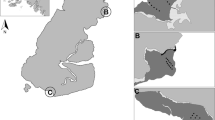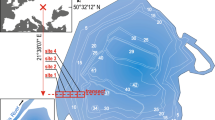Abstract
We studied the macroinvertebrate fauna of a rocky shore in the freshwater tidal Hudson River during 1992–1994, the early years of the zebra mussel (Dreissena polymorpha) invasion. The macroinvertebrate community was numerically dominated by chironomids, nematodes, oligochaetes, gastropods, zebra mussels, and planarian flatworms. The community was a mixture of species typical of stony warm water rivers and lake shores, freshwater generalists, and semiterrestrial species. Overall macroinvertebrate densities were moderate to low (2,800–14,600 m−2). Density was a strong function of season and elevation, with consistently low densities in the early spring and in the intertidal zone. This pattern suggests that physical harshness (alternating submergence and desiccation;ice and low temperatures) limits the distribution of invertebrates at this site. Zebra mussels occurred at our study site chiefly below the low tide mark, but only at moderate abundance (usually <1,000 m−2). A weak correlation between the densities of zebra mussels and those of other macroinvertebrates nonetheless suggests that the zebra mussel invasion may have affected community structure.
Similar content being viewed by others
Literature Cited
Barton, D. R. andH. B. N. Hynes. 1978. Wave-swept macrobenthos of the exposed Canadian shores of the St. Lawrence Great Lakes.Journal of Great Lakes Research 4:27–45.
Botts, P. S., B. A. Patterson, andD. W. Schloesser. 1996. Zebra mussel effects on benthic macroinvertebrates: Physical or biotic?Journal of the North American Benthological Society 15: 179–184.
Charlebois, P. M., J. E. Marsden, R. G. Goettel, R. K. Wolfe, D. J. Jude, andS. Rudnika. 1997. The round goby,Neogobius melanostomus (Pallas), a review of European and North American literature.Illinois Natural History Survey Special Publication 20:1–76.
Dall, P. C., C. Lindegaard, E. Jonsson, G. Jonsson, andP. M. Jonasson. 1984. Invertebrate communities and their environment in the exposed littoral zone of Lake Esrom, Denmark.Archiv für Hydrobiologie Supplementband 69:477–524.
Dermott, R., J. Witt, Y. M. Um, andM. Gonzalez. 1998. Distribution of the Ponto-Caspian amphipodEchinogrammarus ischnus in the Great Lakes and replacement of nativeGammarus fasciatus.Journal of Great Lakes Research 24:442–452.
Downing, J. A. 1979. Aggregation, transformation, and the design of benthos sampling programs.Canadian Journal of Fisheries and Aquatic Sciences 36:1454–1463.
Ellsworth, J. M. 1986. Sources and sinks for fine-grained sediments in the lower Hudson River.Northeastern Geology 8:141–155.
Fisher, S. G. andA. LaVoy. 1972. Differences in littoral fauna due to fluctuating water levels below a hydroelectric dam.Journal of the Fisheries Research Board of Canada 29:1472–1476.
Jokinen, E. H. 1992. The freshwater snails (Mollusca: Gastropoda) of New York state.Bulletin of the New York State Museum 482:1–112.
Limburg, K. E., M. A. Moran, andW. H. McDowell. 1986. The Hudson River Ecosystem. Springer-Verlag, New York.
Little, C. andJ. A. Kitching. 1996. The Biology of Rocky Shores. Oxford University Press, Oxford, England.
Mellina, E. andJ. B. Rasmussen. 1994. Occurrence of zebra mussel (Dreissena polymorpha) in the intertidal region of the St. Lawrence estuary.Journal of Freshwater Ecology 9:81–84.
Merritt, R. W. andK. W. Cummins (eds.). 1996. An Introduction to the Aquatic Insects of North America. 3rd edition. Kendall-Hunt, Dubuque, Iowa.
Odum, W. E., T. J. Smith, J. K. Hoover, and C. McIvor. 1984. The Ecology of Tidal Freshwater Marshes of the United States East Coast: A Community Profile. United States Fish and Wildlife Service FWS/OBS-83/17. Washington, D.C.
Paine, R. T. 1994. Marine Rocky Shores and Community Ecology: An Experimentalist's Perspective. Ecology Institute, Oldendorf, Germany.
Pieczynska, E. 1972. Ecology of the eulitoral zone of lakes.Ekologia Polska 20:637–732.
Prescott, K. 2000. The effects of zebra mussels (Dreissena polymorpha) and wave exposure on benthic macroinvertebrate communities.Occasional Publications of the Institute of Ecosystem Studies 14:32–36.
Ricciardi, A. andJ. B. Rasmussen. 1998. Predicting the identity and impact of future biological invaders: A priority for aquatic resource management.Canadian Journal of Fisheries and Aquatic Sciences 55:1759–1765.
Ricciardi, A., F. G. Whoriskey, andJ. B. Rasmussen. 1997. The role of the zebra mussel (Dreissena polymorpha) in structuring macroinvertebrate communities on hard substrata.Canadian Journal of Fisheries and Aquatic Sciences 54:2596–2608.
Simpson, K. W., R. W. Bode, J. P. Fagnani, andD. M. DeNicola. 1984. The Freshwater Macrobenthos of the Main Channel, Hudson River. Part B. Biology, Taxonomy and Distribution of Resident Macrobenthic Species. Final Report 8/83A/39. Hudson River Foundation. New York.
Simpson, K. W., J. P. Fagnani, R. W. Bode, D. M. DeNicola, andL. E. Abele. 1986. Organism-substrate relationships in the main channel of the lower Hudson River.Journal of the North American Benthological Society 5:41–57.
Stewart, T. W. andJ. M. Haynes. 1994. Benthic macroinvertebrate communities of southwestern Lake Ontario following invasion ofDreissena.Journal of Great Lakes Research 20:479–493.
Stewart, T. W., J. G. Miner, andR. L. Lower. 1998. Quantifying mechanisms for zebra mussel effects on benthic macroinvertebrates: Organic matter production and shell-generated habitat.Journal of the North American Benthological Society 17:81–94.
Strayer, D. 1987. Ecology and zoogeography of the freshwater mollusks of the Hudson River basin.Malacological Review 20: 1–68.
Strayer, D. L., J. Powell, P. Ambrose, L. C. Smith, M. L. Pace, andD. T. Fischer. 1996. Arrival, spread, and early dynamics of a zebra mussel (Dreissena polymorpha) population in the Hudson River estuary.Canadian Journal of Fisheries and Aquatic Sciences 53:1143–1149.
Strayer, D. L. andL. C. Smith. 1993. Distribution of the zebra mussel (Dreissena polymorpha) in estuaries and brackish waters, p. 715–727.In T. F. Nalepa and D. W. Schloesser (eds.), Zebra Mussels: Biology, Impacts, and Control. Lewis Publishers, Boca Raton, Florida.
Strayer, D. L., L. C. Smith, andD. C. Hunter. 1998. Effects of the zebra mussel (Dreissena polymorpha) invasion on the macrobenthos of the freshwater tidal Hudson River.Canadian Journal of Zoology 76:419–425.
Witt, J. D. S., P. D. N. Hebert, andW. B. Morton. 1997.Echinogammarus ischnus: Another crustacean invader in the Laurentian Great Lakes basin.Canadian Journal of Fisheries and Aquatic Sciences 54:264–268.
Author information
Authors and Affiliations
Corresponding author
Rights and permissions
About this article
Cite this article
Strayer, D.L., Smith, L.C. Macroinvertebrates of a rocky shore in the freshwater tidal Hudson River. Estuaries 23, 359–366 (2000). https://doi.org/10.2307/1353328
Received:
Accepted:
Issue Date:
DOI: https://doi.org/10.2307/1353328




